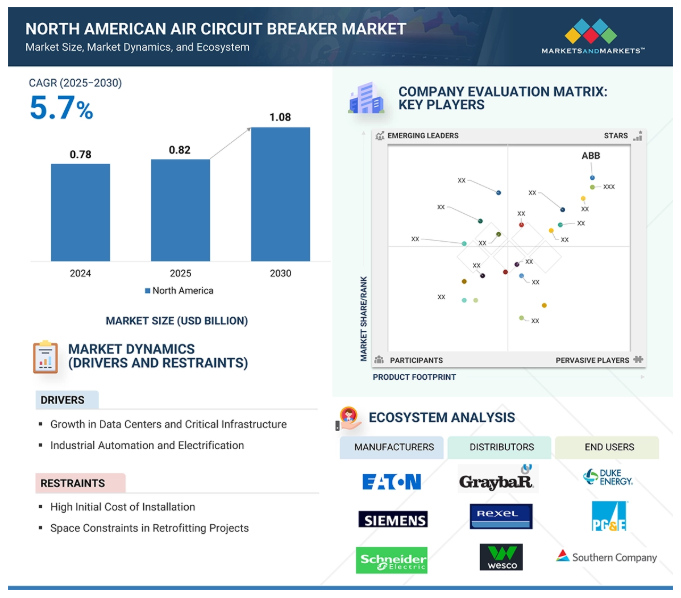The North American air circuit breaker market is projected to grow from USD 0.82 billion by 2025 to USD 1.08 billion by 2030, at a CAGR of 5.7%.
The North American air circuit breaker (ACB) market is likely to continue experiencing steady growth up to 2030, driven by growing investments in grid modernization, industrial automation, and renewable energy infrastructure in the United States and Canada. With aging legacy electrical systems and the growing need for uninterrupted power supply, utilities, commercial buildings, and industrial plants are turning toward ACBs due to their reliability, superior breaking capacity, and simplicity of integration with smart monitoring systems. Federal investment programs such as the IIJA (Infrastructure Investment and Jobs Act) and the Inflation Reduction Act are directing significant investment toward developing substations, transmission infrastructure, and power distribution systems. ACBs have an essential function in protection and load control. Besides that, the growth in renewable energy installations, electric vehicle charging points, and data centers has increased demand for high-endurance, flexible switchgear that can handle load fluctuations and grid complexity, further supporting the demand for air circuit breakers. Technological improvements in arc flash protection, remote diagnostics, and modular designs improve ACB applicability in today’s power infrastructure. As the North American continent moves toward a digital, resilient, and sustainable grid power infrastructure, there are enormous opportunities for ACB manufacturers to address transforming utility, commercial, and industrial needs with next-generation technologies.
By type, air blast circuit breakers are expected to hold larger market share throughout forecast period
The air blast circuit breaker segment is expected to capture a significant share of the North American air circuit breaker market during the forecast period because of its better performance traits and applicability in medium-voltage and high-demand applications. Air blast circuit breakers utilize compressed high-pressure air to rapidly and effectively extinguish arcs, and as such, are suited for applications that demand the high-speed interruption of fault currents, such as power plants, industrial substations, and extensive business complexes. Their high-speed performance capability to manage frequent operations and guarantee greater electrical safety ranks them higher than simple air circuit breakers in mission-critical applications. In addition, air blast breakers generally represent lower maintenance requirements and longer life cycles, which add to their attractiveness for utility and industrial customers looking for long-term dependability and operational efficiency. As North America continues replacing aging infrastructure and incorporating renewable energy and distributed generation, demand for high-performance, arc-resistant switching technologies such as air blast circuit breakers is anticipated to grow steadily.
Download PDF Brochure @ https://www.marketsandmarkets.com/pdfdownloadNew.asp?id=51384614
By voltage, low voltage segment to account for majority of market share throughout forecast period.
The low-voltage segment is anticipated to hold a larger market share of the North American air circuit breaker market during the forecast period, owing to its extensive usage in industrial, commercial, and infrastructure sectors. Low-voltage air circuit breakers, rated below 1 kV, play a vital role in the protection of electrical circuits in industrial plants, commercial facilities, data centers, hospitals, and institutional building environments where electrical security, equipment protection, and continuity of power are paramount. They are preferred due to their simplicity of installation, economic implications, and compatibility with intelligent monitoring systems and are, therefore, appropriate for contemporary energy management approaches. Also, contributing to the growth is the relentless growth of data centers, fast-paced commercial growth, and the upgrading of electrical infrastructure in cities throughout the US and Canada. As the focus on energy efficiency, automation, and smart grid compatibility intensifies, the low-voltage ACB segment is poised to continue leading the market.
US to lead North American market during forecast period
During the forecast period, the US is expected to dominate the North American air circuit breaker market due to massive infrastructure upgrades, increasing industrial automation, and robust policy support for clean energy integration and grid reliability. As the American government launches projects under the Infrastructure Investment and Jobs Act (IIJA) and the Inflation Reduction Act (IRA), considerable investments are going into modernizing substations, replacing old switchgear, and making power distribution networks more resilient. The nation’s strong industrial sector, increasing data center count, and increasing use of clean energy sources such as wind and solar have increased the need for smart air circuit breakers to manage power safely and efficiently. Moreover, the mandatory safety measures and energy efficiency standards imposed by organizations such as the US Department of Energy (DOE) are speeding up the integration of smart, low-maintenance ACBs for digital monitoring. Based on a well-developed electrical infrastructure and aggressive efforts in energy transition, the US will lead the region’s market in terms of volume and value.
Key Players
Some prominent players in the North American air circuit breaker market are ABB Ltd. (Switzerland), Schneider Electric (France), Mitsubishi Electric Corporation (Japan), Eaton (Ireland), and Siemens AG (Germany). These players aggressively invest in product innovation, regional production expansion, and strategic acquisitions to meet the region’s increasing demand for sophisticated circuit protection systems. As North America’s electrical infrastructure undergoes digitalization, decarbonization, and decentralization efforts, these companies target intelligent air circuit breakers with IoT-based monitoring, arc flash protection, and remote diagnostic capabilities. The focus is on providing compact, cybersecure, and easy-to-maintain ACBs capable of facilitating renewable energy integration, critical infrastructure, and high-density urban developments. Partnerships with utilities, electric contractors, and grid operators form the core of their plans, particularly in aligning the design of products with changing safety codes such as UL, IEEE, and NEC standards. In addition, further investment in domestic manufacturing and R&D facilities in the US and Canada makes it possible to achieve quicker delivery cycles, customized product configurations, and compliance with federal infrastructure programs, cementing these companies’ leadership roles in industrial, commercial, and utility markets.
Request Free Sample Report @ https://www.marketsandmarkets.com/requestsampleNew.asp?id=51384614

